www.foodpackautomation.com
05
'24
Written on Modified on
PROCESS STAGES IN FOOD PROCESSING INDUSTRIES
Milton D’Silva presents a brief overview of the many facets of the global food processing industry.

A wide choice of bottled beverages. Photo by Junjie Xu on Pexels
The very mention of food evokes strong emotions and many yearnings. For the hungry, food becomes the only thing needed at that moment, regardless of taste and choice. To those organising a celebration, food is a matter of great importance where the menu is carefully selected taking into account the preferences of guests, especially in a multicultural environment, catering to different tastes and palates, apart from choices. Every community, country, region and even religion has evolved its own food choices and preferences and the way it is harvested, slaughtered and cooked. Great conversations are struck over food, diplomacy conducted, rituals observed, births celebrated and deaths mourned. Food is thus central to human life, and has been so since the dawn of civilisation.
Food is also one of the basic necessities of life that contains nutrients which are essential to keep the human mind and body together. From the earliest – mostly meat-based diet of hunters-gathers-foragers to the later switchover to plant-based diet with the invention of agriculture, food has played a major role in the evolution of the modern human being. In fact scientists and researchers believe that the growth of the larger human brain during this evolution over millions of years is the result of ingesting nutritionally dense mass of muscles of other animals.
The six major nutrients in food are:
1. Carbohydrates – Provide energy for the body.
The very mention of food evokes strong emotions and many yearnings. For the hungry, food becomes the only thing needed at that moment, regardless of taste and choice. To those organising a celebration, food is a matter of great importance where the menu is carefully selected taking into account the preferences of guests, especially in a multicultural environment, catering to different tastes and palates, apart from choices. Every community, country, region and even religion has evolved its own food choices and preferences and the way it is harvested, slaughtered and cooked. Great conversations are struck over food, diplomacy conducted, rituals observed, births celebrated and deaths mourned. Food is thus central to human life, and has been so since the dawn of civilisation.
Food is also one of the basic necessities of life that contains nutrients which are essential to keep the human mind and body together. From the earliest – mostly meat-based diet of hunters-gathers-foragers to the later switchover to plant-based diet with the invention of agriculture, food has played a major role in the evolution of the modern human being. In fact scientists and researchers believe that the growth of the larger human brain during this evolution over millions of years is the result of ingesting nutritionally dense mass of muscles of other animals.
The six major nutrients in food are:
1. Carbohydrates – Provide energy for the body.
- Sources: Grains (bread, rice, pasta), fruits, vegetables, legumes (beans, lentils), dairy products, and starchy vegetables like potatoes and corn.
2. Proteins – Build and repair body tissues.
- Sources: Animal products (meat, poultry, fish, eggs, dairy), legumes (beans, lentils, peas), nuts, seeds, and whole grains like quinoa and farro.
3. Fats – Provide energy, absorb vitamins, and maintain healthy skin and hair.
- Sources: Animal products (meat, poultry, fish, eggs, dairy), nuts, seeds, avocados, and oils (olive, coconut, vegetable).
4. Vitamins – Regulate various bodily functions and processes.
- Sources: Vitamin A – Sweet potatoes, carrots, dark leafy greens, liver, and fatty fish; Vitamin C – Citrus fruits, berries, bell peppers, broccoli, and tomatoes; Vitamin D – Fatty fish, fortified dairy products, sunlight exposure; and other vitamins – Whole grains, legumes, nuts, seeds, and a variety of fruits and vegetables.
5. Minerals: Support bodily functions, bone health, and fluid balance.
- Sources: Calcium – Dairy products, leafy greens, fortified plant-based milk, tofu; Iron – Red meat, poultry, fish, beans, lentils, fortified cereals; Potassium – Bananas, avocados, sweet potatoes, spinach, and beans; and other minerals – Nuts, seeds, whole grains, and a variety of fruits and vegetables.
6. Water: Essential for hydration, digestion, and bodily functions.
- Sources: Plain water, fruits, vegetables, and other beverages like milk, juice, and tea.
It's important to note that a balanced diet should include a variety of foods from all these sources to ensure adequate intake of all essential nutrients.

Agriculture is the main source of food. Image by wirestock on Freepik
The main source of food is agriculture, which also includes animal husbandry or livestock, aquaculture or fisheries and forest produce. The food, thus produced, has traditionally been either plant-based or animal-based. Plants are the foundation of the food chain, producing glucose through the process of photosynthesis. Herbivorous animals or herbivores feed on plants, carnivorous animals or carnivores feed on herbivores, and that forms the food chain, transferring energy from one level to the next. While this may appear a rather simplistic explanation, the fact is plants and animals are the fundamental sources of food.
Major food groups
Based on the agricultural produce, there are five major food groups. These include:
1. Fruits: Provide essential vitamins, minerals, and antioxidants.

Agriculture is the main source of food. Image by wirestock on Freepik
The main source of food is agriculture, which also includes animal husbandry or livestock, aquaculture or fisheries and forest produce. The food, thus produced, has traditionally been either plant-based or animal-based. Plants are the foundation of the food chain, producing glucose through the process of photosynthesis. Herbivorous animals or herbivores feed on plants, carnivorous animals or carnivores feed on herbivores, and that forms the food chain, transferring energy from one level to the next. While this may appear a rather simplistic explanation, the fact is plants and animals are the fundamental sources of food.
Major food groups
Based on the agricultural produce, there are five major food groups. These include:
1. Fruits: Provide essential vitamins, minerals, and antioxidants.
- Examples: Apples, bananas, berries, citrus fruits, tropical fruits like mangoes and pineapples.
2. Vegetables: Rich in vitamins, minerals, and fibre.
- Examples: Leafy greens like spinach and kale, broccoli, bell peppers, carrots, tomatoes, and starchy vegetables like potatoes and corn.
3. Protein Foods: Build and repair body tissues.
- Examples: Animal products like meat, poultry, fish, eggs, and dairy; plant-based options like beans, lentils, peas, nuts, and seeds.
4. Whole Grains: Provide energy, fibre, and essential nutrients.
- Examples: Brown rice, quinoa, whole wheat bread, whole grain pasta, oats, and barley.
5. Dairy or Calcium-Fortified Alternatives: Support bone health and provide essential nutrients.
- Examples: Milk, cheese, yogurt, fortified plant-based milk like soy milk and almond milk, and calcium-fortified juices and cereals.
These five groups form the foundation of a balanced diet, and it's recommended to consume a variety of foods from each group to ensure adequate nutrition.

Agriculture also includes livestock. Image by teksomolika on Freepik
According to the Food and Agriculture Organization (FAO), a specialised agency of the United Nations that leads international efforts to defeat hunger, unmanaged natural agricultural practices can feed barely 10 percent of the global population, which today stands at 8.1 billion. It is thanks to the miracle of modern agricultural practices and scientific research that the world today grows more than enough food, though unequitable distribution means there are millions who go hungry. Another bit of statistics, this one from a 2021 United Nations Environment Program (UNEP) report, is that one third of all food produced is lost or wasted – around 1.3 billion tonnes of food – costing the global economy close to US$940 billion each year.
Food is thus big business. According to Statista, revenue in the global food market amounts to US$9.12 trillion in 2024. The largest segment of this is meat with a market volume of US$1.46tn in 2024. The overall market is expected to grow at a CAGR of 6.47% during the 5-year period from 2024-2029.
It is against this background that food processing and its various stages assume colossal importance. Speaking specifically about food wastage, which can occur at the consumer end, where food is thrown away, or as post-harvest loss – in storage, transport, packaging, or other stages before food reaches the table, it is the latter that can be addressed to a great extent with better food processing technologies, but more on this later.
Basic stages of food processing
Before proceeding with any kind of processing, the food is first harvested from the farm, or in case of poultry, selected for further action. The raw food materials collected from the farm undergo the process of cleaning and sorting that involves removing dirt, debris, and unwanted materials; and sorting based on size, quality, etc.

Farmers harvesting broccoli. Photo by Mark Stebnicki on Pexel
The three basic stages of food processing are:
Primary Processing: This involves minimal transformation of raw ingredients into a usable form. The purpose of primary processing is to preserve the natural state of the food while making it safe for consumption or further processing. It focuses on preparing food for consumption or further processing. For example:

Agriculture also includes livestock. Image by teksomolika on Freepik
According to the Food and Agriculture Organization (FAO), a specialised agency of the United Nations that leads international efforts to defeat hunger, unmanaged natural agricultural practices can feed barely 10 percent of the global population, which today stands at 8.1 billion. It is thanks to the miracle of modern agricultural practices and scientific research that the world today grows more than enough food, though unequitable distribution means there are millions who go hungry. Another bit of statistics, this one from a 2021 United Nations Environment Program (UNEP) report, is that one third of all food produced is lost or wasted – around 1.3 billion tonnes of food – costing the global economy close to US$940 billion each year.
Food is thus big business. According to Statista, revenue in the global food market amounts to US$9.12 trillion in 2024. The largest segment of this is meat with a market volume of US$1.46tn in 2024. The overall market is expected to grow at a CAGR of 6.47% during the 5-year period from 2024-2029.
It is against this background that food processing and its various stages assume colossal importance. Speaking specifically about food wastage, which can occur at the consumer end, where food is thrown away, or as post-harvest loss – in storage, transport, packaging, or other stages before food reaches the table, it is the latter that can be addressed to a great extent with better food processing technologies, but more on this later.
Basic stages of food processing
Before proceeding with any kind of processing, the food is first harvested from the farm, or in case of poultry, selected for further action. The raw food materials collected from the farm undergo the process of cleaning and sorting that involves removing dirt, debris, and unwanted materials; and sorting based on size, quality, etc.

Farmers harvesting broccoli. Photo by Mark Stebnicki on Pexel
The three basic stages of food processing are:
Primary Processing: This involves minimal transformation of raw ingredients into a usable form. The purpose of primary processing is to preserve the natural state of the food while making it safe for consumption or further processing. It focuses on preparing food for consumption or further processing. For example:
- Washing, sorting, and grading fruits and vegetables
- Slaughtering and cleaning animals
- Milking and pasteurising dairy products, and
- Harvesting and threshing grains, etc.
Secondary Processing: This stage involves transforming the primary processed ingredients into intermediate, more complex and palatable products. It includes activities like cleaning, sorting, grading, milling, and other basic preparation processes. The secondary stage requires more extensive processing, such as cooking, mixing, or fermentation. Secondary processing creates products that can be used as ingredients for further processing or consumed directly. For example:
- Canning, freezing, or dehydrating fruits and vegetables
- Grinding grains into flour or meal
- Curing or smoking meats, and
- Producing dairy products like cheese, yogurt, or butter.
Tertiary Processing: This is the final stage, where the food products are processed into ready-to-eat or convenience items, creating final consumer products. This stage requires advanced processing techniques and often involves preserving and fortifying foods with added nutrients or flavours, and packaging and labeling them for convenience. Tertiary processing focuses on creating convenient, shelf-stable products that are ready for consumption. Examples include:
- Baking bread, cakes, or pastries
- Manufacturing snack foods, like chips or crackers
- Producing ready-to-eat meals, like frozen dinners or soups, and
- Creating beverages, like juice, soda, or beer.
Advanced stages of food processing
The secondary and tertiary stages of food processing may further be divided into various sub-processes that are used in processing food on an industrial scale for larger distribution networks. Here are some of the key processes involved:
Formulation and Enrichment: This involves adding various ingredients like preservatives, vitamins, minerals, flavors, and colours. Some of the preparations are also fortified to enhance their nutritional content by adding vitamins and minerals.
Shaping and Forming: There are a few processes here like moulding and extruding, which are adopted to create specific shapes and textures, such as pasta, snacks, or candies. The other processes like filling and stuffing involve putting fillings into casings or containers, such as sausages or stuffed pastries.
Preservation: This is an important process in the food processing chain so as to keep the food fresh and edible throughout its shelf life. The process of preservation takes various forms:
The secondary and tertiary stages of food processing may further be divided into various sub-processes that are used in processing food on an industrial scale for larger distribution networks. Here are some of the key processes involved:
Formulation and Enrichment: This involves adding various ingredients like preservatives, vitamins, minerals, flavors, and colours. Some of the preparations are also fortified to enhance their nutritional content by adding vitamins and minerals.
Shaping and Forming: There are a few processes here like moulding and extruding, which are adopted to create specific shapes and textures, such as pasta, snacks, or candies. The other processes like filling and stuffing involve putting fillings into casings or containers, such as sausages or stuffed pastries.
Preservation: This is an important process in the food processing chain so as to keep the food fresh and edible throughout its shelf life. The process of preservation takes various forms:
- Canning: Sealing food in containers and heating to kill microorganisms.
- Freezing: Lowering temperature to preserve food and extend shelf life.
- Drying and Dehydration: Removing moisture to prevent spoilage.
- Pasteurisation: Heating to destroy pathogens and extend shelf life without compromising quality.

Food processing helps increase shelf life. Image by Steve Buissinne from Pixabay
Packaging and Labeling: Food packaging is very important in order to ensure that it is not crushed or damaged, exposing it to contamination as well. Use of appropriate packaging materials and effective sealing of the packages is essential to protect them from contamination and extend shelf life. Further, correct labeling that provides information about the product, including ingredients, nutritional content, retail price and expiration date, etc.
Quality Control and Testing: Every consignment of packaged food undergoes rigorous inspection to ensure that the products meet safety and quality standards. Before that, samples are tested and analysed for contaminants, consistency, and compliance with regulations.
Storage and Distribution: Since food products are highly perishable if not stored under ideal conditions, warehousing and transportation has to be under appropriate conditions in terms of temperature, humidity and other conditions, e.g., the cold chain or other necessary conditions are maintained stringently.
Retail and Consumer Sales: The process is complete with Marketing & Sales when the products are made available for purchase by consumers, and then by collecting and analysing their feedback to improve products and processes.
These stages are not mutually exclusive, and some processes may overlap. However, they provide a general framework for understanding the progression of food processing from raw ingredients to final consumer products. These three basic stages of food processing have now turned into a massive food processing industry globally. According to a recent report by Evolve Business Intelligence, a market research company, the global food processing market size is expected to reach USD 633.30 billion by 2033, from USD 200.3 billion in 2023, growing at a compound annual growth rate (CAGR) of 12.2%.
How processed food helps minimise wastage
Globally there are many countries that are food surplus and a few that are barely self-sufficient and face food insecurity. Unlike grain, fruits and vegetables have a limited shelf life and spoil easily. Food processing can significantly minimise wastage through various methods, enhancing the efficiency of the food supply chain and extending the shelf life of products. Here are some ways food processing contributes to reducing waste:
- Extended Shelf Life: Methods such as canning, freezing, drying, and pasteurisation help prolong the shelf life of food products, reducing the likelihood of spoilage. Methods such as vacuum packaging: that remove air from packaging help prevent oxidation and microbial growth, keeping food fresh longer.
- Utilisation of By-products: Processed food generates by-products, which can be used to create additional products. For example, whey from cheese production can be used in protein supplements. The waste generated in the process can be converted into animal feed or organic fertilizers, thus minimising waste and promoting sustainability.
- Enhanced Processing Efficiency: Modern machinery and techniques improve the precision of processing, minimising the amount of food discarded due to imperfections. Automated systems reduce human error, leading to more consistent quality and less waste.
- Portion Control and Packaging: With single-serving packages the risk of food going bad before it can be consumed is reduced substantially. Also, resealable packaging allows consumers to use only what they need and keep the rest fresh for later use.
- Value Addition: Converting raw agricultural products into more stable forms, such as turning fresh tomatoes into canned tomatoes or sauce, reduces waste, as it is not always possible to consume whatever is produced immediately. Another point is by adding nutrients to food products, these can be made more valuable and less likely to be wasted. Such fortified food products are also used in organised efforts to address hunger and malnourishment or in disaster relief operations.
- Consumer Education: Providing clear information on storage, preparation, and expiration dates helps consumers use food more efficiently and reduce household waste. Educating consumers about the benefits of processed foods and how to use them properly can reduce waste at the consumer level.
These advantages of food processing play a crucial role in minimising food wastage and ensuring that more food reaches those who need it.
Equipment and automation in food processing
Modern food processing has evolved into a highly automated industry employing a wide range of sophisticated machinery, equipment and automation technologies with real-time connectivity facilitated by the Industry 4.0 era. According to market research agency Fortune Business Insights, the global food processing and handling equipment market size was valued at USD 106.89 billion in 2022. The market is projected to grow from USD 112.45 billion in 2023 to USD 163.23 billion by 2030, exhibiting a CAGR of 5.5% during the forecast period. The report further notes that several enterprises are focusing on the integration of advanced concepts such as IoT to enhance the user experience. IoT-integrated companies to achieve the highest level of food safety, cut down wastage, improve traceability, and reduce costs and risks associated with various food processing and packaging processes, subsequently contributing to the growth of the global market.
The range of equipment includes, but is not restricted to:
Equipment and automation in food processing
Modern food processing has evolved into a highly automated industry employing a wide range of sophisticated machinery, equipment and automation technologies with real-time connectivity facilitated by the Industry 4.0 era. According to market research agency Fortune Business Insights, the global food processing and handling equipment market size was valued at USD 106.89 billion in 2022. The market is projected to grow from USD 112.45 billion in 2023 to USD 163.23 billion by 2030, exhibiting a CAGR of 5.5% during the forecast period. The report further notes that several enterprises are focusing on the integration of advanced concepts such as IoT to enhance the user experience. IoT-integrated companies to achieve the highest level of food safety, cut down wastage, improve traceability, and reduce costs and risks associated with various food processing and packaging processes, subsequently contributing to the growth of the global market.
The range of equipment includes, but is not restricted to:
- Conveyors and Belts: Transport raw materials, ingredients, and finished products.
- Mixing and Blending Equipment: Combine ingredients in specific proportions.
- Grinders and Crushers: Reduce particle size for processing.
- Heat Exchangers: Pasteurise, sterilise, or cook products.
- Pumps and Valves: Handle liquids, semi-solids, and gases.
- Ovens and Fryers: Cook, bake, or fry products.
- Separation Equipment: Sort, grade, and separate materials.
- Homogenisers and Emulsifiers: Blend and stabilise mixtures.
- Cleaning and Sanitation Equipment: Maintain hygiene and prevent contamination.
- Aseptic Processing Equipment: Handle sterile products and prevent contamination.
- X-ray and Metal Detection Systems: Inspect products for contaminants.
- Quality Control and Inspection Systems: Monitor and ensure product quality.
- Modified Atmosphere Packaging (MAP) Machinery: Control gas composition for packaging.
- Fillers and Packaging Machinery: Fill containers, label, and package products.
- Automation Systems: Control and monitor processes, including:
- Programmable Logic Controllers (PLCs)
- Supervisory Control and Data Acquisition (SCADA) systems
- Robotics and Machine Vision
- Sensors and Actuators
These technologies help ensure efficient, safe, and high-quality food processing, from raw material handling to final packaging and distribution.

Scientist configuring a food-processing machine. Image from freepik
Top 10 food processing companies in the world
The top 10 food processing companies in the world, based on their market value and revenue, often include a mix of global giants known for their broad range of products and extensive distribution networks. Here are some of the leading companies in the food processing industry:
Nestlé (Switzerland)
Switzerland-based Nestlé SA (Nestlé), a manufacturer and marketer of food products and beverages, is the world’s largest food processing company with a turnover of CHF 93.0 billion (2023).
PepsiCo (United States)
With roots dating back to 1898, PepsiCo Inc., is an American multinational food, snack, and beverage corporation headquartered in Harrison, New York. Its many iconic brands generate more than $1 billion each in estimated annual retail sales.
Unilever (Netherlands/United Kingdom)
Unilever PLC is a British multinational fast-moving consumer goods company organised into five business groups: Beauty & Wellbeing, Personal Care, Home Care, Nutrition, and Ice Cream. The company’s turnover in 2023 was Euro 59.6 billion.
JBS (Brazil)
JBS S.A is the world’s largest meat processing enterprise, engaged in producing factory processed beef, chicken, salmon, pork, and their by-products. In 2023, global revenue of JBS amounted to approximately 72.9 billion USD.
Tyson Foods (United States)
Tyson Foods is a modern, multi-national, protein-focused food company producing approximately 20% of the beef, pork and chicken in the United States. In 2023, global revenue of Tyson Foods amounted to approximately 53 billion USD.
Anheuser-Busch InBev (Belgium)
Anheuser-Busch InBev NV/SA (AB InBev) is a producer, distributor, and marketer of beer, alcoholic beverages, and soft drinks. In 2023, global revenue of AB InBev amounted to approximately 59.38 billion USD.
Cargill (United States)
Cargill, Incorporated, is an American multinational food corporation based in Minnetonka, Minnesota, employing over 160,000 employees in 66 countries. In 2023, global revenue of Cargill Inc., amounted to 177 billion USD.
The Coca-Cola Company (United States)
The Coca-Cola Company is an American multinational corporation founded in 1892 that manufactures soft drinks including Coca-Cola, and other alcoholic and non-alcoholic beverages. In 2023, global revenue of Coca-Cola Company amounted to approximately 46 billion USD.
Danone (France)
Danone S.A., a French multinational food-products corporation based in Paris. It is built on four businesses: Essential Dairy and Plant-Based Products, Waters, Early Life Nutrition and Medical Nutrition. In 2023, global revenue of Danone S.A amounted to 29.89 billion USD.
Archer Daniels Midland (ADM) (United States)
The Archer-Daniels-Midland Company, commonly known as ADM, is an American multinational food processing and commodities trading corporation. In 2023, global revenue of ADM amounted to 93 billion USD.
These companies have a significant global presence and are known for their wide range of food and beverage products. The rankings can vary depending on the criteria used, such as market capitalisation, revenue, or brand value.
Summing up
The importance of food, and hence the food process industry, can never be overstated. Food is at the core of the Sustainable Development Goals (SDGs), the United Nations’ development agenda for the 21st century. Of the 17 SDGs of the UN, the second is to ‘End hunger, achieve food security and improve nutrition and promote sustainable agriculture’. The UN and its many associate organisations like the Food and Agriculture Organization (FAO), World Food Programme (WFP), International Fund for Agricultural Development (IFAD) and even the World Bank, are working with governments and partner organisations to improve food security and build a food system that can feed everyone, everywhere, every day.
Food processing helps meet the food demands of a growing global population. Besides, it creates jobs, stimulates economic growth, and increases access to food markets. Food processing enables the production of seasonal foods throughout the year. By utilising food parts that would otherwise be discarded, food processing also helps eliminate waste. Overall, food processing plays a vital role in ensuring a stable, safe, and convenient food supply while also supporting economic growth and nutrition enhancement.
References
1. https://www.statista.com/outlook/cmo/food/worldwide
2. https://evolvebi.com/report/food-processing-market-analysis/
3. https://www.fortunebusinessinsights.com/industry-reports/food-processing-and-handling-equipment-market-101701
4. https://www.un.org/en/global-issues/food

Scientist configuring a food-processing machine. Image from freepik
Top 10 food processing companies in the world
The top 10 food processing companies in the world, based on their market value and revenue, often include a mix of global giants known for their broad range of products and extensive distribution networks. Here are some of the leading companies in the food processing industry:
Nestlé (Switzerland)
Switzerland-based Nestlé SA (Nestlé), a manufacturer and marketer of food products and beverages, is the world’s largest food processing company with a turnover of CHF 93.0 billion (2023).
PepsiCo (United States)
With roots dating back to 1898, PepsiCo Inc., is an American multinational food, snack, and beverage corporation headquartered in Harrison, New York. Its many iconic brands generate more than $1 billion each in estimated annual retail sales.
Unilever (Netherlands/United Kingdom)
Unilever PLC is a British multinational fast-moving consumer goods company organised into five business groups: Beauty & Wellbeing, Personal Care, Home Care, Nutrition, and Ice Cream. The company’s turnover in 2023 was Euro 59.6 billion.
JBS (Brazil)
JBS S.A is the world’s largest meat processing enterprise, engaged in producing factory processed beef, chicken, salmon, pork, and their by-products. In 2023, global revenue of JBS amounted to approximately 72.9 billion USD.
Tyson Foods (United States)
Tyson Foods is a modern, multi-national, protein-focused food company producing approximately 20% of the beef, pork and chicken in the United States. In 2023, global revenue of Tyson Foods amounted to approximately 53 billion USD.
Anheuser-Busch InBev (Belgium)
Anheuser-Busch InBev NV/SA (AB InBev) is a producer, distributor, and marketer of beer, alcoholic beverages, and soft drinks. In 2023, global revenue of AB InBev amounted to approximately 59.38 billion USD.
Cargill (United States)
Cargill, Incorporated, is an American multinational food corporation based in Minnetonka, Minnesota, employing over 160,000 employees in 66 countries. In 2023, global revenue of Cargill Inc., amounted to 177 billion USD.
The Coca-Cola Company (United States)
The Coca-Cola Company is an American multinational corporation founded in 1892 that manufactures soft drinks including Coca-Cola, and other alcoholic and non-alcoholic beverages. In 2023, global revenue of Coca-Cola Company amounted to approximately 46 billion USD.
Danone (France)
Danone S.A., a French multinational food-products corporation based in Paris. It is built on four businesses: Essential Dairy and Plant-Based Products, Waters, Early Life Nutrition and Medical Nutrition. In 2023, global revenue of Danone S.A amounted to 29.89 billion USD.
Archer Daniels Midland (ADM) (United States)
The Archer-Daniels-Midland Company, commonly known as ADM, is an American multinational food processing and commodities trading corporation. In 2023, global revenue of ADM amounted to 93 billion USD.
These companies have a significant global presence and are known for their wide range of food and beverage products. The rankings can vary depending on the criteria used, such as market capitalisation, revenue, or brand value.
Summing up
The importance of food, and hence the food process industry, can never be overstated. Food is at the core of the Sustainable Development Goals (SDGs), the United Nations’ development agenda for the 21st century. Of the 17 SDGs of the UN, the second is to ‘End hunger, achieve food security and improve nutrition and promote sustainable agriculture’. The UN and its many associate organisations like the Food and Agriculture Organization (FAO), World Food Programme (WFP), International Fund for Agricultural Development (IFAD) and even the World Bank, are working with governments and partner organisations to improve food security and build a food system that can feed everyone, everywhere, every day.
Food processing helps meet the food demands of a growing global population. Besides, it creates jobs, stimulates economic growth, and increases access to food markets. Food processing enables the production of seasonal foods throughout the year. By utilising food parts that would otherwise be discarded, food processing also helps eliminate waste. Overall, food processing plays a vital role in ensuring a stable, safe, and convenient food supply while also supporting economic growth and nutrition enhancement.
References
1. https://www.statista.com/outlook/cmo/food/worldwide
2. https://evolvebi.com/report/food-processing-market-analysis/
3. https://www.fortunebusinessinsights.com/industry-reports/food-processing-and-handling-equipment-market-101701
4. https://www.un.org/en/global-issues/food

